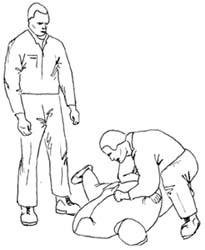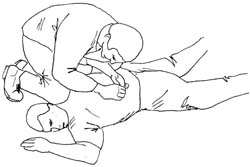Tactical C&R - Control and Restraint
by Tank Todd,
Army Special Forces Close Combat Master Chief Instructor
21cm x 29.5cm - 50 pages - illustrated
NZ$40 including
G.S.T. &
P&P within New Zealand
NZ$50
including P&P to Australia
NZ$55
including P&P to rest of the world
Click
here to purchase via Fight Times store
International Orders: email us for details
TACTICAL VS TECHNICAL
I have learned, disregarded and forgotten more holds than I care to
remember for one simple reason; they were not tactically correct, were
unsafe and would only stand to impress an audience at a demonstration;
not overcome a serious threat
Over technical studio techniques may well impress when demonstrated on
a willing assistant but how many willing assistants will you ever have
to restrain in the course of your duties?
You do not have to restrain the willing compliant or submissive, its
the belligerent aggressive type that need to be restrained and I have
never seen this type offer you their limbs for restraining.
You need to ask yourself if you could apply your technical studio
skills while a determined offender was viciously attacking you.
Sound tactics, procedures and skills give you and your team the best
chance of success in a bad situation, nothing more, nothing less. There
is no point in finding out that your fancy demonstration, technically
complicated studio techniques do not stand up when you are at the sharp
end of a tough situation.
I could have shown you countless secondary skills or application
variations, but that would have defied the purpose of this manual; to
provide the best in tactics, procedures, principles, skills and
applications. The rest comes with
practice, experience and physical instruction.
INTRODUCTION
Tactical Control and Restraint is the result of my lifetimes work in
the fields of military, security and law enforcement as a consultant,
instructor, and as a member and chief of crowd control teams.
For the past twenty-five years I have designed and perfected, as close
as humanly possible, skills and procedures both for my security team
and personnel of psychiatric institutions, large security companies, as
well as law enforcement, prison personnel and the military.
The contents of this text has been designed for it’s simplicity,
effectiveness, tactical correctness and most importantly safety both
for the staff and the suspect.
The entire aim of this field manual is to promote the proven skills
that achieve maximum results with minimum effort and a high level of
safety throughout the entire application.
While it is true there are no skills or procedures that are foolproof,
or the end all and be all, the following system provided it is used in
accordance with sound basic principles and common sense, provides the
best chance of operational success.
Often one finds in civilian restraint groups, individuals whom are not
confident due to lack of proper training, or others whom can not
operate as a team, or whom feel vulnerable due to having to work with
incompetent personnel.
The following text is designed to dissuade the over zealous, heroic
type application and promote the safe team options, the most important
ingredient is the team players individual inner resolve, something that
no manual or system can provide.
Samples from Tactical C&R - Control and Restraint
BASIC
PRINCIPLES
Never forget your basics - safe approach, open mind
assessment,
correct tactics and procedure applications. Don't use historical,
traditional or competitive methods. Success requires knowledge of
skills that incorporate least line of resistance principles, knowledge
of the anatomy and the scientific principles of leverage, balance and
momentum.
Always be prepared to change from one skill to another for example
instead of skill application one, two, three, be prepared to go one,
three, or vice versa.
Always be completely familiar with team procedures in all applications
including cross training for all contingencies or emergencies.
Let common sense prevail. A combination of skill and will are the
required attributes, not heroic or over zealous behaviour.
Select your security team members wisely for their physical
capabilities as well as their practical intelligence and ability to be
members of a team. Where situations require, the individual should also
be capable of operating on his own or as a leader.
Always attempt to use a diplomatic, verbal approach to defuse a
potential situation, as every time you opt for a physical approach, you
run the risk of physical injury or inciting an even more volatile
situation.
In countries where flashlights and other such security tools are
carried, always make sure they are easily accessible should the
situation require them. But do not carry them in such a way to
intimidate or offend.
Clothing for security work should be practical, comfortable and hard
wearing, not tight or restrictive in any way.
Footwear should be safety shoes or preferably boots for extra support,
the internal steel safety cap types are recommended.
Any equipment, keys, weapons, etc. should be carried in a safe pocket,
pouch or position for easy access, they should also be well secured to
avoid the possibility of offenders turning your own equipment on you
and should be well maintained.
Never panic in any situation as this leads to [... continued]
STATIC GUARD TACTICS AND
PROCEDURES
Ensure that your rear flanks are safe. Position yourself so that you
have the greatest overall vision of the entry/exit points and both
sides of approach.
Scan the area for threats or potential threats. Remember prevention is
better than cure and to prevent entry is far easier than to have to
remove an offender.
Communicate in a firm, fair and friendly manner. When restricting entry
use calm definite verbalisation combined with, if necessary clear
universal
[...continued]
IN AN OFFENSIVE
APPLICATION
In an offensive application make your approach directly diagonally to
the offender's side, secure his arm at the wrist and above the elbow in
an escort position; (see escort position). Now apply a distraction
skill followed by
[...continued]
PSYCHOLOGICAL
You must be able to control your heart rate to maintain the ability to
perform physical skills effectively.
As the heart rate rises, the skill level lowers and the ability to
remain focused and in complete control deteriorates.
The higher the stress level, the lower the skill level and lesser the
reaction time.
These stress factors are affected even further due to the fact that the
operator may have to verbally command the offender or communicate as
part of his duties in a high stress situation. Speech even further
reduces individual reaction time.
Post situation operators need to be physically strong, especially in
situations where they have been wounded or failed in their duties.
They need to take a realistic look at every aspect of the event and
learn from it so as to be more
[...continued]
CONTENT
The following subjects and techniques are covered in the book:
|
|
SAFE SECURE AND SEARCH POSITION
| Using
one of the previous arm locks, take the offender to the ground on his
stomach. Position one of your knees carefully across the back of his
neck and the thigh of the other against his upper arm. Note prior to the restraint take down, verbally inform the offender that you require him to lie flat on his stomach to avoid decentralization panic and advance resistance. Figure A |
|
|
Now
grasp two or three of the fingers of the secured arm and lever
backwards. You can give him clear instructions from this secured
position and if he is uncooperative, increase the pressure of the
leverage. Figure B You can have him put his free hand up his back for cuffing and carefully search him from this position. |
Back to Todd Systems Close Combat Books
Looking for information on close combat training? Read more about Todd Close Combat Systems in the Close Combat Files.
Related Products
-
Primary Option Control & Restraint DVD
This control and restraint DVD is the result of over twenty-five years designing and perfecting skills and procedures for security teams, personnel of psychiatric institutions, large security companies, law enforcement, prison personnel and the military. The DVD promotes the proven skills that achieve maximum results with minimum effort and a high level of safety throughout the entire application
March 2013
Annual International Close Combat Course
Location: Todd Group Headquarters, Dunedin, New Zealand
Phase 3 exponent continuation training Thurday March 21st to Saturday March 23rd 2013
Phase 3 instructor training Sunday March 24th to Saturday March 30th 2013
Phase 1 & 2 Sunday March 24th to Saturday March 30th 2013
Stay up to date with Todd Group news and training opportunities. Click here to join the Todd Group Mailing List.


